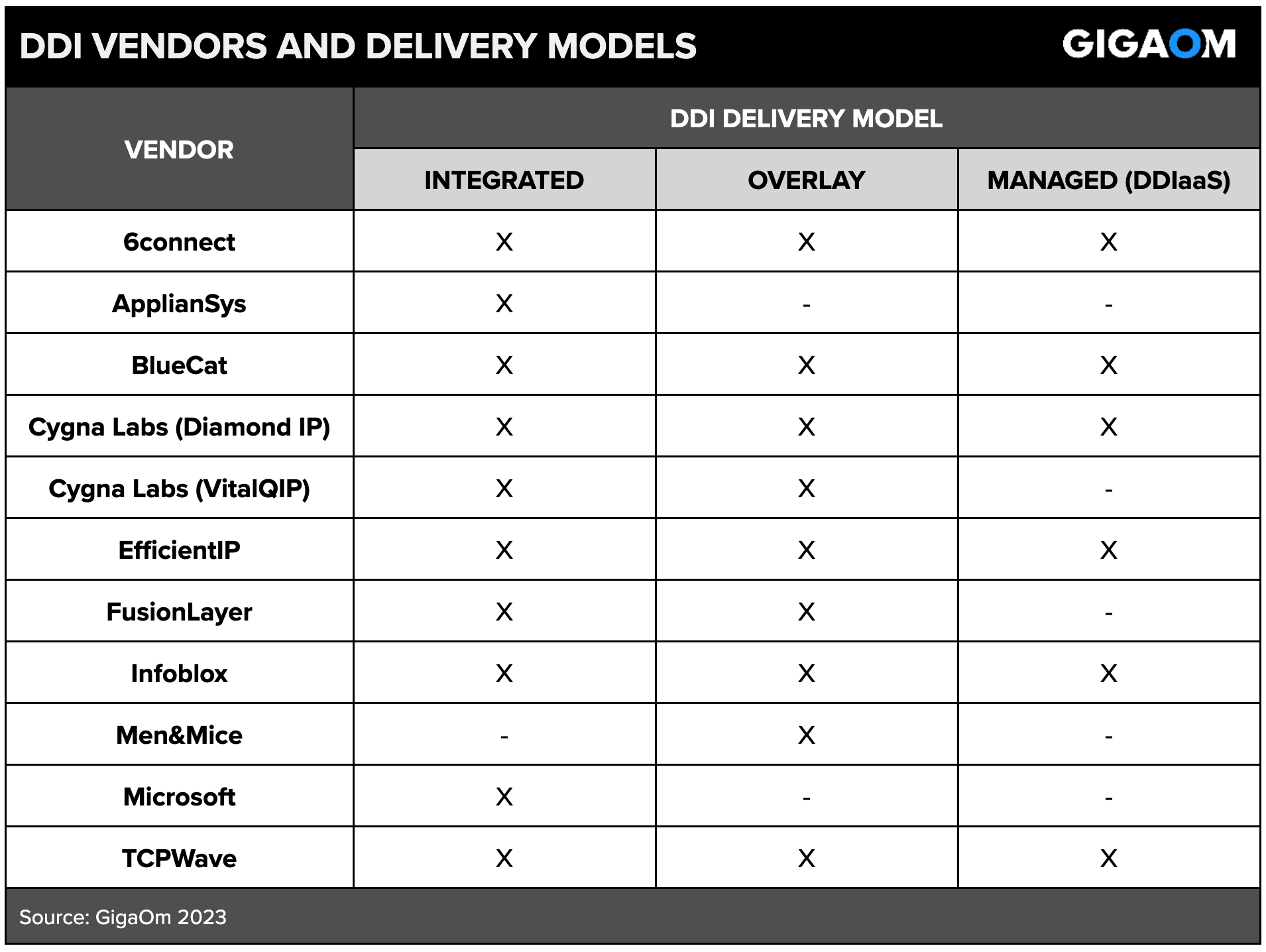Table of Contents
- Summary
- Market Categories and Deployment Types
- Key Criteria Comparison
- GigaOm Radar
- Vendor Insights
- Analyst’s Take
- Methodology
- About Ivan McPhee
- About GigaOm
- Copyright
1. Summary
DDI is shorthand for DNS, DHCP, and IP address management (IPAM). An integrated DDI solution provides increased visibility into potential IP conflicts in real time, a context for audits and reporting, and a structured workflow for basic network operations. It enables routine maintenance tasks to be automated and reduces the cost of network operations. However, with DNS mapping the IP addresses to names, DHCP assigning the IP addresses to hosts, and IPAM managing IP resources for both, using different tools introduces unnecessary risks and compromises an organization’s security posture.
This GigaOm Radar report highlights key DDI vendors and equips IT decision-makers with the information needed to select the best fit for their business and use case requirements. In the corresponding GigaOm report, “Key Criteria for Evaluating DDI Solutions,” we describe in more detail the capabilities and metrics that are used to evaluate vendors in this market.
This is our second year evaluating the DDI space in the context of our Key Criteria and Radar reports. All solutions included in this Radar report meet the following table stakes—capabilities widely adopted and well implemented in the sector:
- Integrated DNS, DHCP, and IPAM (DDI): An integrated DDI solution provides administrators with complete control and visibility of the relationship among devices, users, and IP addresses from a single pane of glass, enabling automated maintenance tasks for increased resiliency, security, scalability, and support with complete auditing and reporting context. An integrated solution updates records in real time, eliminating the gap between IP address usage and reporting, enabling bring your own technology (BYOT), internet of things (IoT), and cloud, virtual, and emerging technologies to be selectively deployed and seamlessly managed without worrying about addressing conflicts.
- Built-in DNS management: Purpose-built domain name system (DNS) management platforms allow network administrators to configure, manage, and visualize all aspects of DNS operations across cloud, physical, and virtual environments at scale via an intuitive user interface (UI). Incorporating DNS monitoring, security, and traffic control, role-based DNS management solutions use intelligent forwarding to optimize path resolution, apply policies to prevent unauthorized access, log internal and external DNS queries, simplify the tracking and monitoring of DNS assets and resources, and integrate with third-party security products for rapid threat detection and mitigation.
- Built-in DHCP management: Managing the torrent of requests from fixed and mobile devices requiring connectivity, dynamic host configuration protocol (DHCP) management tools simplify and automate the process of configuring devices on a network, ensuring that devices have the appropriate network settings, reducing configuration errors, and enabling the efficient management of IP addresses. In addition, centralizing critical information for network connectivity—such as the size and location of routers, subnets, IP address hostnames, and IP address spaces—prevents IP conflicts and optimizes the use of IP addresses available in the network.
- Built-in IPAM management: A single source of truth for all network assets, an IPAM manager helps administrators discover, organize, track, and fine-tune data related to a network’s IP address space. Providing advanced IP scanning and IP address tracking, IPAM allows IP addresses to be managed efficiently from a centralized IP management console. For example, hierarchies can be defined, subnets added based on location or usage, and the network scanned to obtain the real-time status of each IP address. Among other features, robust IPAM solutions should include role-based administration, flexible scanning, alert notification, and powerful search capabilities.
With so many different DDI solutions and the landscape evolving, choosing the best option for your organization depends on your use cases, existing DNS and DHCP solutions, architectural choices, and in-house capabilities. Your current environment, growth plans, and in-house skill sets will most likely influence your decision about adopting an integrated, overlay, or managed DDI solution.

Figure 1. DDI Vendors and Delivery Models
Moreover, even if you’ve already deployed a DDI solution, don’t let that hold you back from exploring new management options and vendors with robust migration tools and services. In some cases, migrating to a new DDI solution can deliver significant benefits in terms of manageability and long-term cost savings.
How to Read this Report
This GigaOm report is one of a series of documents that helps IT organizations assess competing solutions in the context of well-defined features and criteria. For a fuller understanding, consider reviewing the following reports:
Key Criteria report: A detailed market sector analysis that assesses the impact that key product features and criteria have on top-line solution characteristics—such as scalability, performance, and TCO—that drive purchase decisions.
GigaOm Radar report: A forward-looking analysis that plots the relative value and progression of vendor solutions along multiple axes based on strategy and execution. The Radar report includes a breakdown of each vendor’s offering in the sector.